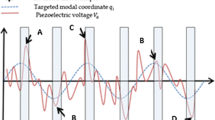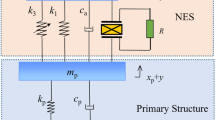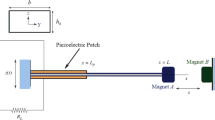Abstract
In a previous work, the authors investigated, with promising results, the use of a piezoelectric element for the sake of energy harvesting from a rod assemblage subjected to varying normal force. However, in that occasion it was also observed that, depending on the initial voltage applied to the piezoelectric element, the system’s vibrations could actually be controlled, due to structural stiffening associated to the so-called inverse effect, inherent to piezoelectric coupling. In this work, this duality (energy harvesting and vibration control) is further exploited. It is shown that one or the other feature may arise in a parametric-instability scenario. The same trend was also captured with the aid of a reduced-order model.









Similar content being viewed by others
References
Clough RW, Penzien J (2003) Dynamics of structures, 2nd edn. McGraw-Hill Education, New York, p 739
Vakakis AF (1997) Non-linear normal modes (NNMs) and their applications in vibration theory: an overview. Mech Syst Signal Process 11(1):3–22
Vakakis AF (1992) Non-similar normal oscillations in a strongly non-linear discrete system. J Sound Vib 158(2):341–361
Vakakis AF (2009) Nonlinear normal modes, part I: a useful framework for the structural dynamicist. Mech Syst Signal Process 23(1):170–194
Lenci S, Mazzilli CEN (2017) Asynchronous free oscillations of linear mechanical systems: a general appraisal and a digression on a column with a follower force. Int J Non-Linear Mech 94:223–234
Lenci S, Mazzilli CEN (2017) Asynchronous modes of vibrations in linear conservative systems: an illustrative discussion of plane framed structures. Meccanica 52:3131–3147
Mazzilli CEN, Lenci S (2017) Asynchronous modes of vibration in a heavy-chain model. In: 17th International symposium on dynamics problems of mechanics, São Sebastião, São Paulo, Brazil
Mazzilli CEN, Lenci S (2017) Asynchronous modes of vibration in a heavy-chain model with linear and rotational springs. In: 9th European nonlinear dynamics conference, Budapest
Ribeiro EAR, Mazzilli CEN, Lenci S (2018) Influence of geometric nonlinearities on the asynchronous modes of an articulated prestressed slender structure. J Vib Acoust 141:021007-1-9
Mazzilli CEN, Ribeiro EAR (2018) Asynchronous modes of beams on elastic media subjected to varying normal force: continuous and discrete models. In: Symposium on exploiting nonlinear dynamics for engineering systems (IUTAM), Novi
Ribeiro EAR, Lenci S, Mendes BAP, Mazzilli CEN (2019) Modal asynchronicity in a simply-supported beam with a cantilever extension. In: XXIV AIMETA conference
Ribeiro EAR, Lenci S, Mazzilli CEN (2020) Modal localisation in a beam modelled as a continuous system: a discussion on the use of auxiliary oscillators. J Sound Vib
Mendes BAP, Mazzilli CEN, Ribeiro EAR (2019) Parametric instability of a heavy-chain model with an asynchronous vibration mode. In: First international nonlinear dynamics conference, Rome
Mendes BAP, Mazzilli CEN, Ribeiro EAR (2019) Energy harvesting in a slender-rod model with modal asynchronicity. Nonlinear Dyn 55:1–14
Shen W, Zhu S (2014) Harvesting energy via electromagnetic damper: application to bridge stay cables. J Intell Mater Syst Struct 26:3–19
Shen W, Zhu S, Zhu H (2016) Experimental study on using electromagnetic devices on bridge stay cables for simultaneous energy harvesting and vibration damping. Smart Mater Struct 25:065011
Shen W, Zhu S, Zhu H (2019) Unify energy harvesting and vibration control functions in randomly excited structures with electromagnetic devices. J Eng Mech 145:04018115
Shen WA, Zhu S, Xu YL (2012) An experimental study on self-powered vibration control and monitoring system using electromagnetic TMD and wireless sensors. Sens Actuators A Phys 180:166–176
Tang X, Zuo L (2012) Simultaneous energy harvesting and vibration control of structures with tuned mass dampers. J Intell Mater Syst Struct 23:2117–2127
Harne RL (2013) Modeling and analysis of distributed electromagnetic oscillators for broadband vibration attenuation and concurrent energy harvesting. Appl Math Model 37:4360–4370
Kecik K, Mitura A (2020) Energy recovery from a pendulum tuned mass damper with two independent harvesting sources. Int J Mech Sci 174:105568
Chtiba MO, Choura S, Nayfeh AH, El-Borgi S (2010) Vibration confinement and energy harvesting in flexible structures using collocated absorbers and piezoelectric devices. J Sound Vib 329:261–276
Huang SC, Tsai CY, Liao HH (2016) Parametric study on a collocated PZT beam vibration absorber and power harvester. J Mech Sci Technol 30:4877–4885
Huang SC, Nguyen LH, Liang JW, Huang YM (2018) Design and analysis of a collocated periodic vibration absorber–harvester. Int J Mech Sci 148:337–351
Zhu S, Shen WA, Xu YL (2012) Linear electromagnetic devices for vibration damping and energy harvesting: modeling and testing. Eng Struct 34:198–212
Wolfram Research (1988) Wolfram Mathematica. Wolfram Research, Inc., Mathematica, Version 12.0, Champaign, IL (2019)
Nayfeh AH, Mook DT (1979) Nonlinear oscillations. Wiley, New York
Acknowledgements
The second author acknowledges the support of CNPq (National Council for Scientific Development), Brazil, under Grant 301050/2018-0. The third author acknowledges the support of FAPESP (São Paulo Research Foundation), Brazil, under Grant 2018/12858-3.
Author information
Authors and Affiliations
Corresponding author
Ethics declarations
Conflict of interest
The authors declare that they have no conflict of interest.
Additional information
Publisher's Note
Springer Nature remains neutral with regard to jurisdictional claims in published maps and institutional affiliations.
Appendices
Appendix A
The unveiled terms of the stiffness matrix \( {\mathbf{K}}\left( {\varvec{q},\dot{\varvec{q}},\tau } \right) \), not detailed in (31) for brevity, read
Appendix B
The unveiled terms of (59) read
Rights and permissions
About this article
Cite this article
Mendes, B.A.P., Ribeiro, E.A.R. & Mazzilli, C.E.N. Piezoelectric vibration controller in a parametrically-excited system with modal localisation. Meccanica 55, 2555–2569 (2020). https://doi.org/10.1007/s11012-020-01195-1
Received:
Accepted:
Published:
Issue Date:
DOI: https://doi.org/10.1007/s11012-020-01195-1




